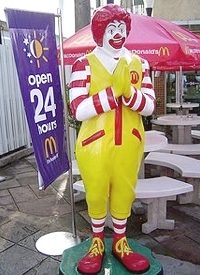
Corporate Accountability International launched a campaign against the Joe Camel cigarette mascot in the 1990s and has now turned its attention to Ronald McDonald. On Wednesday, the organization took out a full-page advertisement in the Chicago Sun Times, New York Metro, and four other newspapers calling for Ronald McDonald’s retirement. Nearly 600 health groups and professionals endorsed the advertisement, which reads, “’Doctors’ Orders: Stop Marketing Junk Food to Kids.”
McDonald’s has defended its mascot, contending that Ronald McDonald encourages children to be active. Though Ronald began as a whimsical and “goofy” mascot in 1963 who served food to happy little children, McDonald’s transformed him in 2004 into a “balanced, active lifestyles ambassador.” At that time, McDonald’s depicted Ronald McDonald in commercials as training for the Olympics. Newer commercials portray him as athletic and sporty, with minimal mention of McDonald’s fast food.
According to The Blaze, the full-page advertisement is just another problem plaguing Ronald McDonald this year:
His floppy shoes, painted-on smile and flaming-red hair may be a harder sell to today’s kids who are trading in their dolls and trucks for manicures and mobile game apps at ever younger ages. He also seems out of step with McDonald’s Corp.’s new efforts to appeal to adults. The 48-year-old spokesclown has fallen flat in new ads this year, according to Ace Metrix, a group that tracks TV advertising.
And the government is getting strict on marketing unhealthy food to children. That has both marginalized Ronald as more of a mascot than a product pitchman and landed him in the middle of the bigger debate about food makers’ responsibilities in stemming the rise in childhood obesity.
In addition to taking out the full-page ad, CAI sent a letter to Jim Skinner, McDonald’s CEO, which reads, “We ask that you heed our concern and retire your marketing promotions for food high in salt, fat, sugar, and calories to children, whatever form they take — from Ronald McDonald to toy giveaways.”
Corporate Accountability International launched a similar campaign against the mascot last year, prompting McDonald’s to defend the clown and declare that they would not consider retiring him.
“It’s totally unfounded,” indicated Marlena Peleo-Lazar, McDonald’s chief creative officer, who also described the mascot as “a force for good.”
Likewise, McDonald’s points to Ronald McDonald’s longevity and popularity as reasons to keep him as the mascot. Recently, Zagat declared Ronald McDonald to be the most popular fast-food mascot, edging out Jared the Subway Guy.
“It would be tough to walk away from him,” said Nigel Hollis of Millward Brown Optimor, who determined that McDonald’s is the fourth-most valuable brand in the world. “It would be almost as if the Geico gecko disappeared, or the Aflac duck.”
As noted by Ace Metrix, however, new Ronald McDonald commercials are failing to pique the interest of test audiences. In a survey of 500 people, a large number of them used the word “creepy” to describe the mascot.
In response, however, Peleo-Lazar said, “For everyone who may feel that way, there are more who feel the opposite.”
Defenders of the mascot point to his service for the Ronald McDonald House Charities, an agency that houses families who must travel to seek medical treatment for a child. Not only is Ronald McDonald the face of the charity, but he also makes appearances at the camps for ailing children and charity events.
Corporate Accountability International spokesman Nick Guroff is unmoved, however. Admitting that Ronald McDonald House Charities is worthy, he contends that “to use that as their excuse for marketing junk food to kids is sort of having their burger and eating it too.”
The efforts against Ronald McDonald are similar to those launched by federal bureaucrats against the marketing of sugary breakfast cereals to children. Last month, the Associated Press reported that new federal guidelines may mandate that companies may market to children between the ages of 2 and 17 only if the products are low in fat, sugar, and sodium, and contain healthy ingredients.




